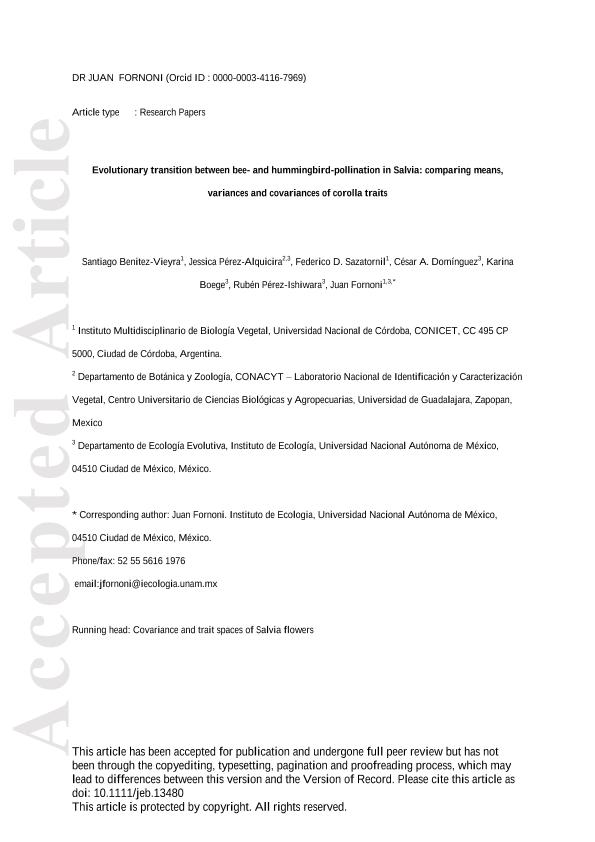Mostrar el registro sencillo del ítem
dc.contributor.author
Benitez-Vieyra, Santiago Miguel

dc.contributor.author
Pérez-Alquicira, Jessica
dc.contributor.author
Sazatornil, Federico David

dc.contributor.author
Domínguez, César A.
dc.contributor.author
Boege, Karina
dc.contributor.author
Pérez Ishiwara, Rubén
dc.contributor.author
Fornoni, Juan Enrique

dc.date.available
2020-10-26T19:54:21Z
dc.date.issued
2019-04
dc.identifier.citation
Benitez-Vieyra, Santiago Miguel; Pérez-Alquicira, Jessica; Sazatornil, Federico David; Domínguez, César A.; Boege, Karina; et al.; Evolutionary transition between bee pollination and hummingbird pollination in Salvia: Comparing means, variances and covariances of corolla traits; Wiley Blackwell Publishing, Inc; Journal of Evolutionary Biology; 32; 8; 4-2019; 783-793
dc.identifier.issn
1010-061X
dc.identifier.uri
http://hdl.handle.net/11336/116862
dc.description.abstract
Covariation among traits can modify the evolutionary trajectory of complex structures. This process is thought to operate at a microevolutionary scale, but its long-term effects remain controversial because trait covariation can itself evolve. Flower morphology, and particularly floral trait (co)variation, has been envisioned as the product of pollinator-mediated selection. Available evidence suggests that major changes in pollinator assemblages may affect the joint expression of floral traits and their phenotypic integration. We expect species within a monophyletic lineage sharing the same pollinator type will show not only similarity in trait means but also similar phenotypic variance-covariance structures. Here, we tested this expectation using eighteen Salvia species pollinated either by bees or by hummingbirds. Our findings indicated a nonsignificant multivariate phylogenetic signal and a decoupling between means and variance-covariance phenotypic matrices of floral traits during the evolution to hummingbird pollination. Mean trait value analyses revealed significant differences between bee- and hummingbird-pollinated Salvia species although fewer differences were detected in the covariance structure between groups. Variance-covariance matrices were much more similar among bee- than hummingbird-pollinated species. This pattern is consistent with the expectation that, unlike hummingbirds, bees physically manipulate the flower, presumably exerting stronger selection pressures favouring morphological convergence among species. Overall, we conclude that the evolution of hummingbird pollination proceeded through different independent transitions. Thus, although the evolution of hummingbird pollination led to a new phenotypic optimum, the process involved the diversification of the covariance structure.
dc.format
application/pdf
dc.language.iso
eng
dc.publisher
Wiley Blackwell Publishing, Inc

dc.rights
info:eu-repo/semantics/openAccess
dc.rights.uri
https://creativecommons.org/licenses/by-nc-sa/2.5/ar/
dc.subject
COVARIANCE SPACE
dc.subject
MORPHOSPACE
dc.subject
PHENOTYPIC INTEGRATION
dc.subject
POLLINATION
dc.subject
SALVIA
dc.subject.classification
Biología

dc.subject.classification
Ciencias Biológicas

dc.subject.classification
CIENCIAS NATURALES Y EXACTAS

dc.subject.classification
Ecología

dc.subject.classification
Ciencias Biológicas

dc.subject.classification
CIENCIAS NATURALES Y EXACTAS

dc.title
Evolutionary transition between bee pollination and hummingbird pollination in Salvia: Comparing means, variances and covariances of corolla traits
dc.type
info:eu-repo/semantics/article
dc.type
info:ar-repo/semantics/artículo
dc.type
info:eu-repo/semantics/publishedVersion
dc.date.updated
2020-09-02T19:06:41Z
dc.identifier.eissn
1420-9101
dc.journal.volume
32
dc.journal.number
8
dc.journal.pagination
783-793
dc.journal.pais
Reino Unido

dc.journal.ciudad
Londres
dc.description.fil
Fil: Benitez-Vieyra, Santiago Miguel. Consejo Nacional de Investigaciones Científicas y Técnicas. Centro Científico Tecnológico Conicet - Córdoba. Instituto Multidisciplinario de Biología Vegetal. Universidad Nacional de Córdoba. Facultad de Ciencias Exactas Físicas y Naturales. Instituto Multidisciplinario de Biología Vegetal; Argentina
dc.description.fil
Fil: Pérez-Alquicira, Jessica. Instituto de Ecología; México
dc.description.fil
Fil: Sazatornil, Federico David. Consejo Nacional de Investigaciones Científicas y Técnicas. Centro Científico Tecnológico Conicet - Córdoba. Instituto Multidisciplinario de Biología Vegetal. Universidad Nacional de Córdoba. Facultad de Ciencias Exactas Físicas y Naturales. Instituto Multidisciplinario de Biología Vegetal; Argentina
dc.description.fil
Fil: Domínguez, César A.. Instituto de Ecología; México
dc.description.fil
Fil: Boege, Karina. Instituto de Ecología; México
dc.description.fil
Fil: Pérez Ishiwara, Rubén. Instituto de Ecología; México
dc.description.fil
Fil: Fornoni, Juan Enrique. Instituto de Ecología; México
dc.journal.title
Journal of Evolutionary Biology

dc.relation.alternativeid
info:eu-repo/semantics/altIdentifier/doi/http://dx.doi.org/10.1111/jeb.13480
dc.relation.alternativeid
info:eu-repo/semantics/altIdentifier/url/https://onlinelibrary.wiley.com/doi/abs/10.1111/jeb.13480
Archivos asociados
